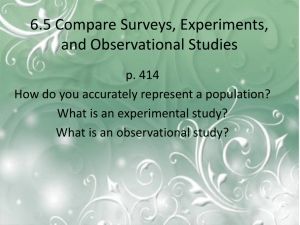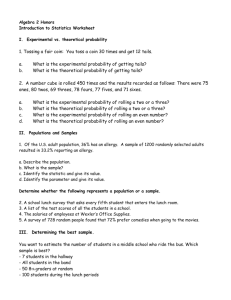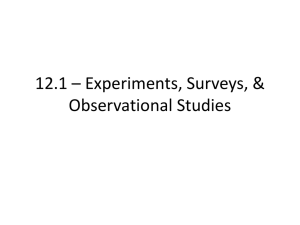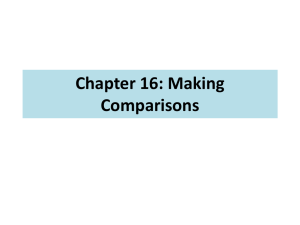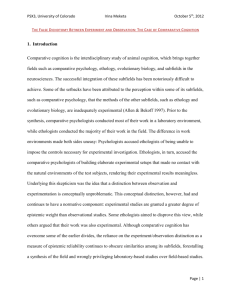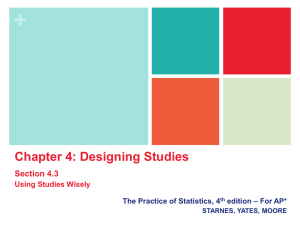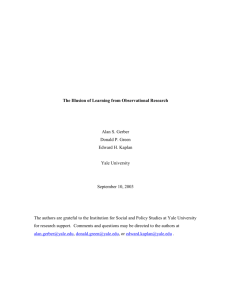6.5 Compare Surveys, Experiments, and Observational Studies
advertisement
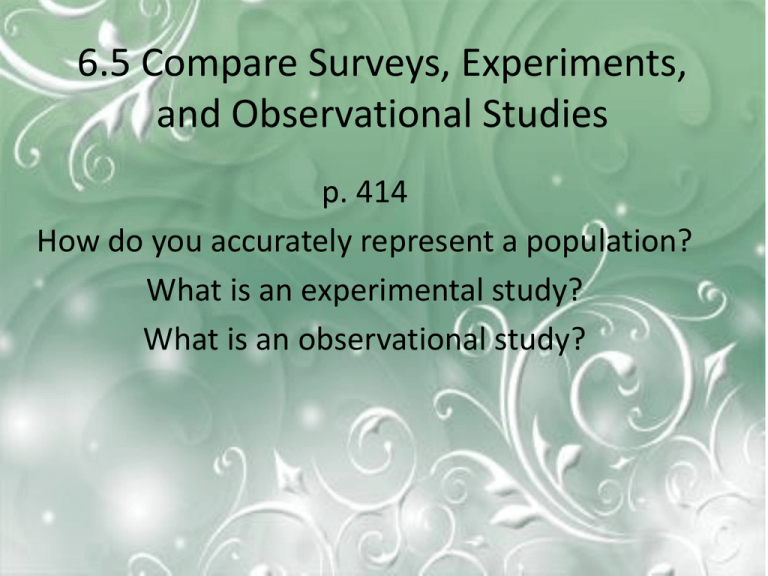
6.5 Compare Surveys, Experiments, and Observational Studies p. 414 How do you accurately represent a population? What is an experimental study? What is an observational study? Identify the type of sample described. Then tell if the sample is biased. Explain your reasoning. 1. A school newspaper posts an online survey on their website about the food served in the cafeteria. They present the results of the students who respond. ANSWER Self-selected; biased; the results show only the feelings of students who volunteer for the survey. Identify the type of sample described. Then tell if the sample is biased. Explain your reasoning. 2. A grocery store wants customers to rate their customer service. The store manager surveys every twentieth customer leaving the store during the day. ANSWER Systematic; unbiased; the sample is representative of the shoppers. Survey Questions • Poorly designed questions may not accurately reflect the opinions or actions of those being surveyed. • Biased questions--questions that are flawed in a way that leads to inaccurate results. Biased Questions Questions may be biased in the following ways: The wording of the question may encourage or pressure the respondent to answer in a particular way. The question may be perceived as too sensitive to answer truthfully. The questions may not provide the respondent with enough information to give an accurate opinion. The order the questions are asked. Respondents giving answers they believe will please the questioner. Tell why the question may be biased or otherwise introduce bias into the survey. Describe a way to correct the flaw. a. This question assumes that the respondent is familiar with the proposal. To get accurate results that lead to valid conclusions, state the proposal clearly using neutral language before asking the question. Tell why the question may be biased or otherwise introduce bias into the survey. Describe a way to correct the flaw. b. Patients who brush less than twice per day or do not floss daily may be afraid to admit this since the dentist is asking the question. One improvement would be to have patients answer questions about dental hygiene on paper and put the paper anonymously into a box. Experimental Studies An experimental study imposed a treatment on individuals in order to collect date on their response to the treatment. Treatment may be a medical treatment, or it can be any action that might affect a variable in the experiment. (ex: adding methanol to gasoline and measuring its effect on fuel efficiency.) Observational Studies An observational study observes individuals and measure variables without controlling the individuals or their environment. It may be difficult to control or isolate the variable being studied. It may be unethical to subject people to a certain treatment or to withhold it from them. Determine whether each situation is an example of an experiment or an observational study. Explain. a. A researcher asks college students how many hours of sleep they get on an average night and examines whether the number of hours of sleep affects students’ grades. The researcher gathers data without controlling the individuals or applying a treatment. The situation is an observational study. Determine whether each situation is an example of an experiment or an observational study. Explain. b. A Parks Department employee wants to know if latex paint is more durable than non-latex paint. She has 50 park benches painted with latex paint and has 50 park benches painted with non-latex paint. A treatment (painting benches with latex paint) is applied to some of the individuals (benches) in the study. The situation is an experiment. 1. Tell whether the survey question below may be biased or otherwise introduce bias into the survey. Explain. “Do you, like most people your age, enjoy watching the latest music videos?” This question may be biased because a respondent may feel pressured to answer a certain way. By answering “no,” a respondent may feel as if he or she is not like most people of the same age. 2. Determine whether the situation described in the research summary shown at the right is an example of an experiment or an observational study. Explain. Experiment; a treatment (use of a new Web site) is imposed on some individuals (Web site users). Controlled Experiments In a controlled experiment, two groups are studied under identical conditions with the exception of over variable. Control group—a group under ordinary conditions. Treatment group—a group that is subjected to the treatment. Randomized Comparative Experiment In a randomized comparative experiment, individuals are randomly assigned to the control group or the treatment group. The comparison of the control group and the treatment group makes it possible to determine any effects of the treatment. Randomization minimizes bias and produces groups of individuals that are theoretically similar in all ways before the treatment is applied. Conclusions drawn from an experiment that is not a randomized comparative experiment may not be valid. Determine whether the study described in the health bulletin below is a randomized comparative experiment. If it is, describe the treatment, the treatment group, and the control group. If it is not, explain why not and discuss whether the conclusions drawn from the study are valid. SOLUTION The study is not a randomized comparative experiment because the individuals were not randomly assigned to a control group and a treatment group. (In fact, the study is an observational study, not an experiment, since no treatment is imposed.) The study’s conclusion that milk fights cavities may or may not be valid. There may be other reasons why students who chose milk had fewer cavities. For example, students who voluntarily choose milk at lunch may be more likely to have other healthy eating or dental care habits that could affect the number of cavities they have. 3. Determine whether the study described in the research summary for Guided Practice Exercise 2 is a randomized comparative experiment. If it is, describe the treatment, the treatment group, and the control group. If it is not, explain why not and discuss whether the conclusions drawn from the study are valid. SOLUTION The study is a randomized comparative experiment; treatment is use of a new Web site; treatment group is individuals using the new Web site; control group is individuals using old Web site. Well Designed Studies The key element of well designed studies is randomization. Notice the part randomization plays in each of the studies. Sample survey –a random sample is selected to be surveyed from the population surveyed. Surveys do not compare groups and do not address cause and effect. Observational survey—as possible,, random samples can be selected for the groups being studies. These studies and surveys are good to compare data from two or more groups looking for a relationship between variables. Experiment—Individuals are assigned at random to the treatment group of the control group. A well designed experiment can determine a cause-and-effect relationship. Comparative Studies and Causality • An observational study can identify correlation between variables, but not causality. Variables other than what is being measured may be affecting the results. (a vigorous exercise in older people correlates with longer life, but comparing groups only on exercise and lifespan ignores other factors, such as that people who are unhealthy to begin with may not be able to exercise vigorously. • A rigorous randomized comparative experiment, by eliminating sources of variation other than the controlled variable, can make valid cause-and-effect conclusions possible. Explain whether the following research topic is best investigated through an experiment or an observational study. Then explain how you would design the experiment or observational study. You want to know if listening to music using earphones for more than one hour per day affects a person’s hearing. SOLUTION The treatment (listening to music using earphones for more than one hour a day) may affect an individual’s hearing, so it is not ethical to assign individuals to a control or treatment group. Use an observational study. SOLUTION Randomly choose one group of individuals who already listen to music using earphones for more than one hour per day. Randomly choose one group of individuals who do not listen to music using earphones for more than one hour per day. Monitor the hearing of the individuals in both groups at regular intervals. 6.5 Assignment Page 418, 2-8, 13-16
